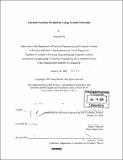| dc.contributor.advisor | Rafael Palacios. | en_US |
| dc.contributor.author | Doshi, Anuja | en_US |
| dc.contributor.other | Massachusetts Institute of Technology. Dept. of Electrical Engineering and Computer Science. | en_US |
| dc.date.accessioned | 2006-07-13T15:13:37Z | |
| dc.date.available | 2006-07-13T15:13:37Z | |
| dc.date.copyright | 2005 | en_US |
| dc.date.issued | 2005 | en_US |
| dc.identifier.uri | http://hdl.handle.net/1721.1/33300 | |
| dc.description | Thesis (M. Eng. and S.B.)--Massachusetts Institute of Technology, Dept. of Electrical Engineering and Computer Science, 2005. | en_US |
| dc.description | Includes bibliographical references (leaf 64). | en_US |
| dc.description.abstract | The Federal Aviation Administration (FAA) has been investigating early warning accident prevention systems in an effort to prevent runway collisions. One system in place is the Airport Movement Area Safety System (AMASS), developed under contract with the FAA. AMASS uses a linear prediction system to predict the position of an aircraft 5 to 30 seconds in the future. The system sounds an alarm to warn air traffic controllers if it foresees a potential accident. However, research done at MIT and Volpe National Transportation Systems Center has shown that neural networks more accurately predict the future position of aircraft. Neural networks are self-learning, and the time required for the optimization of safety logic will be minimized using neural networks. More accurate predictions of aircraft position will deliver earlier warnings to air traffic controllers while reducing the number of nuisance alerts. There are many factors to consider in designing an aircraft position prediction neural network, including history length, types of inputs and outputs, and applicable training data. This document chronicles the design, training, performance, and analysis of a position prediction neural network, and the presents the resulting optimal neural network for the AMASS System. Additionally, the neural network prediction model is then compared other prediction models, including a constant speed, linear regression, and an auto regression model. In this analysis, neural networks present themselves as a superior model for aircraft position prediction. | en_US |
| dc.description.statementofresponsibility | by Anuja Doshi. | en_US |
| dc.format.extent | 72 leaves | en_US |
| dc.format.extent | 3878638 bytes | |
| dc.format.extent | 3881358 bytes | |
| dc.format.mimetype | application/pdf | |
| dc.format.mimetype | application/pdf | |
| dc.language.iso | eng | en_US |
| dc.publisher | Massachusetts Institute of Technology | en_US |
| dc.rights | M.I.T. theses are protected by copyright. They may be viewed from this source for any purpose, but reproduction or distribution in any format is prohibited without written permission. See provided URL for inquiries about permission. | en_US |
| dc.rights.uri | http://dspace.mit.edu/handle/1721.1/7582 | |
| dc.subject | Electrical Engineering and Computer Science. | en_US |
| dc.title | Aircraft position prediction using neural networks | en_US |
| dc.type | Thesis | en_US |
| dc.description.degree | M.Eng.and S.B. | en_US |
| dc.contributor.department | Massachusetts Institute of Technology. Department of Electrical Engineering and Computer Science | |
| dc.identifier.oclc | 62279431 | en_US |
